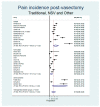Incidence of Post-Vasectomy Pain: Systematic Review and Meta-Analysis
- PMID: 32164161
- PMCID: PMC7084350
- DOI: 10.3390/ijerph17051788
Incidence of Post-Vasectomy Pain: Systematic Review and Meta-Analysis
Abstract
This is the first systematic review and meta-analysis to ascertain incidences of post-vasectomy pain following traditional scalpel, or non-scalpel vasectomy. Electronic databases PubMed, Embase and PsycINFO were searched up to 1 July 2019 for peer-reviewed articles recording post-vasectomy pain. We identified 733 publications, screened 559 after removal of duplicates and excluded 533. Of the remaining 26 full-text articles, 8 were excluded with reasons, leaving 18 for detailed analyses. Meta-analysis was performed on 25 separate datasets (11 scalpel, 11 non-scalpel, 3 other/combined). Study follow-up ranged from 2 weeks to 37 years and sample sizes from 12 to 723 patients. The overall incidence of post-vasectomy pain was 15% (95% CI 9% to 25%). The incidences of post-vasectomy pain following scalpel and non-scalpel techniques were 24% (95% CI 15% to 36%) and 7% (95% CI 4% to 13%), respectively. Post-vasectomy pain syndrome occurred in 5% (95% CI 3% to 8%) of subjects, with similar estimates for both techniques. We conclude that the overall incidence of post-vasectomy pain is greater than previously reported, with three-fold higher rates of pain following traditional scalpel, compared to non-scalpel vasectomy, whereas the incidence of post-vasectomy pain syndrome is similar.
Keywords: meta-analysis; non-scalpel; pain; post-vasectomy pain syndrome; scalpel; systematic review; vasectomy.
Conflict of interest statement
The authors declare no conflict of interest.
Figures



References
Publication types
MeSH terms
LinkOut - more resources
Full Text Sources
Medical

